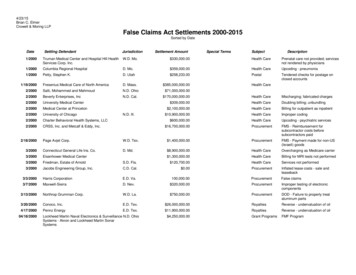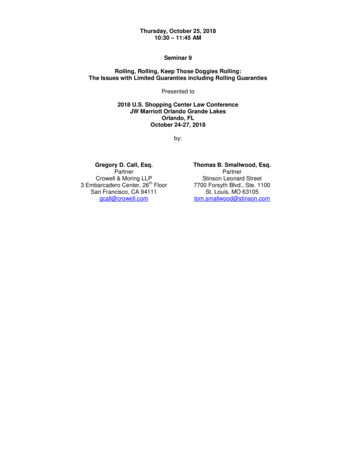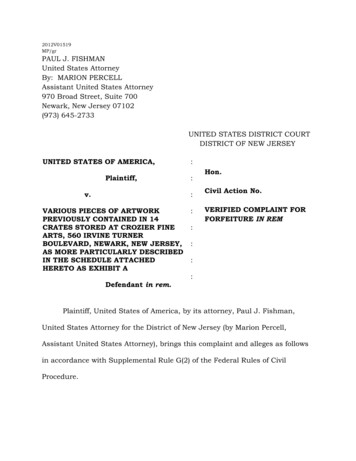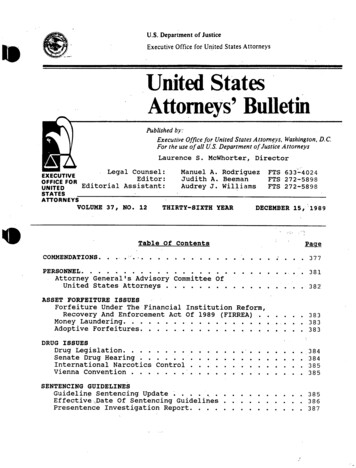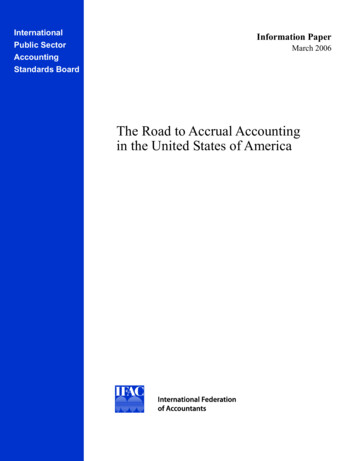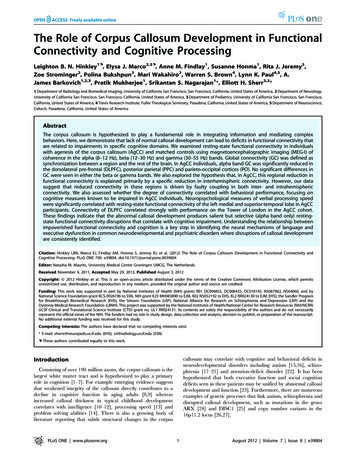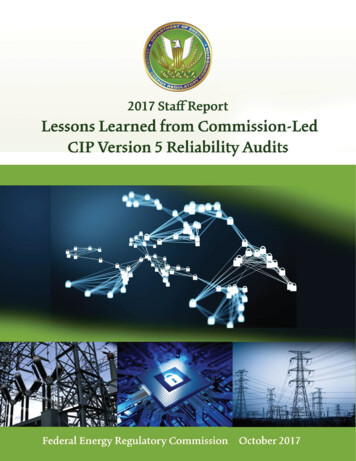
Transcription
UNITED STATES OF AMERICA
FEDERAL ENERGY REGULATORY COMMISSION2017 Staff ReportLessons Learned from Commission-LedCIP Version 5 Reliability AuditsPrepared by Staff of theOffice of Electric ReliabilityFederal Energy Regulatory CommissionWashington, D.C.October 6, 2017The matters presented in this staff report do not necessarily represent the views of the FederalEnergy Regulatory Commission, its Chairman, or individual Commissioners, and are not binding onthe Commission.2017 REPORT ON CIP V5 AUDITS2
Table of ContentsIntroduction . 4CIP Reliability Standards . 5Audit Scope and Methodology . 6Overview of Lessons Learned . 7Lessons Learned Discussion. 9General Practices . 9Identifying BES Cyber Systems . 10Personnel & Training . 12Electronic Security Perimeters . 15Physical Security of BES Cyber Systems . 18Systems Security Management . 19Configuration Management . 21Information Protection . 222017 REPORT ON CIP V5 AUDITS3
IntroductionThe staff of the Division of Reliability Standards and Security in the Office ofElectric Reliability, with assistance of staff from the Division of Audits and Accountingin the Office of Enforcement, of the Federal Energy Regulatory Commission(Commission) has completed non-public audits of several registered entities of theBulk Electric System (BES).1 The audits evaluated the registered entities’ compliancewith the applicable mandatory Reliability Standards for the Bulk-Power SystemCritical Infrastructure Protection (CIP) Reliability Standards (CIP ReliabilityStandards).2 Staff from Regional Entities and the North American Electric ReliabilityCorporation (NERC) participated on the audits, including the on-site portion. Theaudits were completed during Fiscal Years 2016 and 2017 (FY2016 and FY2017,respectively).The audits provided audited entities an assessment of their compliance statusin the audited areas. Staff found that, for the first series of completed non-publicaudits, most of the cyber security protection processes and procedures adopted bythe audited entities met the mandatory requirements of the CIP Reliability Standards.Staff also found instances of potential compliance infractions. Additionally, staffidentified possible areas of improvement in the security posture of audited entitiesthat are not specifically addressed by the CIP Reliability Standards. The auditsafforded audited entities opportunities to learn of areas for improvement in theirsecurity posture and staff recommended proposals to addresses the matters.This anonymized summary report informs the regulated community and thepublic of lessons learned from the audits, including insights into the cyber securityand CIP compliance issues encountered by registered entities. This report providesinformation and recommendations to NERC, Regional Entities, and registered entitiesthat staff believes is useful in their assessments of risk, compliance, and overall cybersecurity. Moreover, this information may be generally beneficial to the utility-basedcyber security community to improve the security of the BES.1BES is defined in the “Glossary of Terms Used in NERC Reliability Standards”(NERC Glossary), http://www.nerc.com/files/glossary of terms.pdf.218 C.F.R. Part 40 (2017).2017 REPORT ON CIP V5 AUDITS4
CIP Reliability StandardsSection 215 of the Federal Power Act (FPA) requires a Commission-certifiedElectric Reliability Organization (ERO) to develop mandatory and enforceableReliability Standards, subject to Commission review and approval. 3 ReliabilityStandards may be enforced by the ERO, subject to Commission oversight, or by theCommission independently. The Commission established a process to select andcertify an ERO,4 and subsequently certified NERC.5Pursuant to section 215 of the FPA, on January 28, 2008, the Commissionapproved an initial set of eight mandatory CIP Reliability Standards pertaining tocybersecurity.6 In addition, the Commission directed NERC to develop certainmodifications to the CIP Reliability Standards. Since 2008, the CIP ReliabilityStandards have undergone multiple revisions to address Commission directives andrespond to emerging cybersecurity issues. The CIP Reliability Standards are designedto mitigate the cybersecurity risks to BES facilities, systems, and equipment, which, ifdestroyed, degraded, or otherwise rendered unavailable as a result of a cybersecurityincident, would affect the reliable operation of the Bulk-Power System.316 U.S.C. 824o (2012).4Rules Concerning Certification of the Electric Reliability Organization; andProcedures for the Establishment, Approval, and Enforcement of Electric ReliabilityStandards, Order No. 672, FERC Stats. & Regs. ¶ 31,204, order on reh’g, Order No. 672A, FERC Stats. & Regs. ¶ 31,212 (2006).5North American Electric Reliability Corp., 116 FERC ¶ 61,062, order on reh’gand compliance, 117 FERC ¶ 61,126 (2006), order on compliance, 118 FERC ¶ 61,190,order on reh’g, 119 FERC ¶ 61,046 (2007), aff’d sub nom. Alcoa, Inc. v. FERC, 564 F.3d1342 (D.C. Cir. 2009).6Mandatory Reliability Standards for Critical Infrastructure Protection, OrderNo. 706, 122 FERC ¶ 61,040, denying reh’g and granting clarification, Order No. 706A, 123 FERC ¶ 61,174 (2008), order on clarification, Order No. 706-B, 126 FERC ¶61,229, order denying clarification, Order No. 706-C, 127 FERC ¶ 61,273 (2009).2017 REPORT ON CIP V5 AUDITS5
Audit Scope and MethodologyThe Commission initiated its CIP Reliability Standards audits of registeredentities of the BES in FY2016. The audits focused on evaluating compliance with CIPReliability Standards version 5 (CIP v5) for the period after July 1, 2016. 7 TheCommission also evaluated compliance with CIP Reliability Standards version 3 (CIPv3), for the period of each audited entity’s last CIP compliance audit through June 30,2016 (the effective end date of CIP v3).8Audit fieldwork primarily consisted of data requests and reviews,teleconferences, and a site visit to each entity’s facilities. Prior to a site visit, staffissued data requests to gather information pertaining to an entity’s CIP activities andoperations, and conducted teleconferences to discuss the audit scope and objectives,data requests and responses, technical and administrative matters, and complianceconcerns. During a site visit, staff interviewed an entity’s subject matter experts(SMEs); observed operating practices, processes, and procedures used by its staff inreal-time; and examined its functions, operations, practices, and regulatory andcorporate compliance culture. Additionally, staff interviewed employees andmanagers responsible for performing tasks within the audit scope and analyzeddocumentation to verify compliance with requirements; conducted several fieldinspections and observed the functioning of certain assets identified by an entity asHigh, Medium, or Low Impact; and interviewed compliance program managers, staff,and employees responsible for day-to-day compliance and regulatory oversightactivities.The data, information, and evidence provided by an entity were evaluated forsufficiency, appropriateness, and validity. Documentation submitted in the form ofpolicies, procedures, e-mails, logs, studies, data sheets, etc., were validated,substantiated, and crosschecked for accuracy as appropriate. For certain CIPReliability Standard Requirements, sampling was performed to test compliance.7Revised Critical Infrastructure Protection Reliability Standards, Order No. 822,154 FERC ¶ 61,037 (2016), reh’g denied, 156 FERC ¶ 61,052; Reliability Standards:CIP-003-6, CIP-004-6, CIP-006-6, CIP-007-6, CIP-009-6, CIP-010-2, and CIP-011-2;Version 5 Critical Infrastructure Protection Reliability Standards, Order No. 791, 145FERC ¶ 61,160 (2013), order on clarification and reh’g, 146 FERC ¶ 61,188 (2014);Reliability Standards: CIP-002-5.1a, CIP-005-5, and CIP-008-5.8Revised Reliability Standards for Critical Infrastructure Protection, 128 FERC¶ 61,291, order denying reh’g and granting clarification, 129 FERC ¶ 61,236 (2009),order on compliance, 130 FERC ¶ 61,271 (2010); Reliability Standards: CIP-002-3,CIP-003-3, CIP-004-3, CIP-005-3, CIP-006-3, CIP-007-3, CIP-008-3, and CIP-009-3.2017 REPORT ON CIP V5 AUDITS6
Overview of Lessons LearnedStaff derived the following lessons learned from the audits it conducted. Theselessons are directed toward responsible entities to improve their compliance with theCIP Reliability Standards and their overall cyber security posture.1.2.3.4.5.6.7.8.9.10.11.12.13.Conduct a thorough review of CIP Reliability Standards compliancedocumentation; identify areas of improvement to include but not be limitedto instances where the documented instructional processes are inconsistentwith actual processes employed or where inconsistencies exist betweendocuments; and modify documentation accordingly.Review communication protocols between business units related to CIPoperations and compliance, and enhance these protocols where appropriateto ensure complete and consistent communication of information.Consider all owned generation assets, regardless of BES-classification, whenevaluating impact ratings to ensure proper classification of BES CyberSystems.Identify and categorize cyber systems used for supporting generation, inaddition to the cyber systems used to directly control generation.Ensure that all shared facility categorizations are coordinated between theowners of the shared facility through clearly defined and documentedresponsibilities for CIP Reliability Standards compliance.Conduct a detailed review of contractor personnel risk assessment processesto ensure sufficiency and to address any gaps.Conduct a detailed review of physical key management to ensure the samerigor in policies and testing procedures used for electronic access is appliedto physical keys used to access the Physical Security Perimeter (PSP).Enhance procedures, testing, and controls around manual transfer of accessrights between personnel accessing tracking systems, Physical AccessControl Systems (PACS), and Electronic Access Control MonitoringSystems (EACMS) or, alternatively, consider the use of automated accessrights provisioning.Ensure that access permissions within personnel access tracking systems areclearly mapped to the associated access rights within PACS and EACMS.Ensure that policies and testing procedures for all electronic communicationsprotocols are afforded the same rigor.Perform regular physical inspections of BES Cyber Systems to ensure nounidentified Electronic Access Points (EAPs) exist.Review all firewall rules and ensure access control lists follow the principleof “least privilege.”For each remote cyber asset conducting Interactive Remote Access (IRA),disable all other network access outside of the connection to the BES CyberSystem that is being remotely accessed, unless there is a documentedbusiness or operational need.2017 REPORT ON CIP V5 AUDITS7
14.15.16.17.18.19.20.21.Enhance processes and controls around the use of manual logs, such as usinghighly visible instructions outlining all of the parts of the requirement witheach manual log, to consistently capture all required information.Enhance processes and procedures for documenting the determination foreach cyber asset that has no provision for disabling or restricting ports, toensure consistency and detail in the documentation.Consider employing host-based malicious code prevention for all cyberassets within a BES Cyber System, in addition to network level prevention,for non-Windows based cyber assets as well as Windows-based cyber assets.Implement procedures and controls to monitor or limit the number ofsimultaneously successful logins to multiple different systems.Implement procedures to detect and investigate unauthorized changes tobaseline configurations.Ensure that all commercially available enterprise software tools are includedin BES Cyber System Information (BSCI) storage evaluation procedures.Enhance documented processes and procedures for identifying BCSI toconsider the NERC Critical Infrastructure Protection Committee (CIPC)guidance document, “Security Guideline for the Electricity Sector:Protecting Sensitive Information.”Document all procedures for the proper handling of BCSI.2017 REPORT ON CIP V5 AUDITS8
Lessons Learned DiscussionGeneral Practices1. Conduct a thorough review of CIP Reliability Standards compliancedocumentation; identify areas of improvement to include but not be limitedto instances where the documented instructional processes are inconsistentwith actual processes employed or where inconsistencies exist betweendocuments; and modify documentation accordingly.Entities generally had sufficient security practices thatsatisfied the CIP Reliability Standards, however documentationon such practices into formal procedures could be improved.All CIPActual practices sometimes included additional steps notReliabilityincluded in the formal documented procedures, or differedStandardsslightly from the written record on the procedures. Suchinconsistencies can have significant impacts on an entity’s cyber security programbecause a lack of complete and accurate documentation of cyber security practicesheightens the risk of improper implementation by employees.Relates To2. Review communication protocols between business units related to CIPoperations and compliance, and enhance these protocols where appropriateto ensure complete and consistent communication of information.Audited entities generally performed adequately withRelates Toregard to having sufficient security controls that satisfied theCIP Reliability Standards, but entities’ communicationsAll CIPbetween their various business units could be improved as toReliabilitythese controls. Clear and consistent communication betweenStandardsoperational departments and an entity’s human resource andinformation technology departments is imperative to CIP Reliability Standardscompliance and the entity’s cyber security posture as a whole. For example, poorcommunication could result in inappropriate delays in revocation of access rights forformer employees or transferred employees.2017 REPORT ON CIP V5 AUDITS9
Identifying BES Cyber Systems3. Consider all owned generation assets, regardless of BES-classification, whenevaluating impact ratings to ensure proper classification of BES CyberSystems.While identification of BES Cyber Systems was generallyperformed adequately by the audited entities, there was someconfusion regarding the generation assets that should beCIP-002-5.1aconsidered when evaluating the rating impact classification ofRequirementBES Cyber Systems.Reliability Standard CIP-002-5.1aR1Identify BESAttachment 1 identifies aggregated thresholds to determine theCyber Systemscategorization of a BES Cyber System. For example, Criteria2.11 requires categorization as Medium Impact of all ControlCenters or backup Control Centers, not already categorized as High Impact, used toperform the functional obligations of the Generator Operator for an aggregate highestrated net Real Power capability of the preceding 12 calendar months equal to orexceeding 1500 MW in a single Interconnection. To determine whether a generationControl Center or back-up Control Center meets the 1500 MW threshold, the MWcapacity of both BES generation and non-BES generation are considered. During auditfieldwork, staff found that some entities were only considering BES generation inapplying Criteria 2.11, and therefore excluding all “non-BES generation” in theircalculations.9Relates ToFor example, a single generator operating with an individual nameplate of 10MVA would not be included in the BES, and thus not have to categorize its cybersystems. However, a Control Center that controls 150 10-MVA generating resourceswould have to categorize its cyber systems, some possibly at a Medium Impactrating.10 Ensuring that all owned generation assets, regardless of BES-classification,are considered in addressing Attachment 1 reduces the risk of improperidentification and classification, and insufficient protection, of BES Cyber Systems.9Per the BES Definition, generation resources are included if connected to anInterconnection at a voltage of 100 kV or above and either (a) a gross individualnameplate rating greater than 20 MVA; or, (b) a gross plant/facility aggregatenameplate rating greater than 75 MVA. The BES definition is not used to determinethe impact rating of BES Cyber Systems. CIP-002-5.1a Attachment 1 does not define,or differentiate between, the terms “BES Generation,” and “Non-BES Generation.”10CIP-002-5.1a (Cyber Security - BES Cyber System Categorization),Attachment 1 (Impact Rating Criteria), Criteria 2.11.2017 REPORT ON CIP V5 AUDITS10
4. Identify and categorize cyber systems used for supporting generation, inaddition to the cyber systems used to directly control generation.Relates ToCIP-002-5.1aRequirementR1Identify BESCyber SystemsWhile identification of BES Cyber Systems that wereused to directly control generation units was generallyperformed adequately by the entities, the identification of BESCyber Systems that are used to control generation “supportsystems” could be improved.11 In many cases inadequatedocumentation of “supporting systems” for BES Cyber Systemsmay have increased the entity’s compliance risk of notcorrectly identifying all BES Cyber Systems.5. Ensure that all shared facility categorizations are coordinated between theowners of the shared facility through clearly defined and documentedresponsibilities for CIP Reliability Standards compliance.Relates ToCIP-002-5.1aRequirementR1Identify BESCyber SystemsThe coordination between two or more owners of ashared BES facility for compliance with the CIP ReliabilityStandards could be improved.The identification andcategorization of the assets at such shared facilities were notconsistently coordinated between the owners. The underlyingoperating agreements did not clearly delineate the complianceresponsibilities of each entity, which heightens the risk ofdevices being overlooked for required protections.11Generator support systems may include fuel handling, water handling, airhandling, exhaust handling, and other systems that are used to support the operationsof the unit.2017 REPORT ON CIP V5 AUDITS11
Personnel & Training6. Conduct a detailed review of the contractor personnel risk assessmentprocesses to ensure sufficiency and to address any gaps.Personnel risk assessments (PRA) were generallyperformed and documented adequately for employees of anentity, but the PRAs for contractors were not consistentlyCIP-004-6performed and documented.These deficiencies largelyRequirementR3resulted from entities not evaluating contractors’ processes orPersonnel Riskauthorizing different PRA processes for contractors than thoseAssessmentthe entities used for their own employees. This led toPrograminconsistencies in performance and documentation thatheighten the risk of improper management of personnel withaccess to BES Cyber Systems.Relates To7. Conduct a detailed review of physical key management to ensure the samerigor in policies and testing procedures used for electronic access is appliedto physical keys used to access the Physical Security Perimeter (PSP).Relates le audited entities generally had sufficient controlsto limit electronic access to their PSP (i.e., keypads or badgereaders for doors), the controls surrounding the use of physicalkeys to access PSPs could be improved. Physical keys were usedless frequently than electronic access, generally providedaccess to lower impact facilities, and/or were only used as asecondary means to electronic access. However, the physicalkeys still provide access to PSPs and should be afforded thesame level of control as afforded for electronic access.2017 REPORT ON CIP V5 AUDITS12
8. Enhance procedures, testing, and controls around manual transfer of accessrights between personnel accessing tracking systems, Physical AccessControl Systems (PACS), and Electronic Access Control MonitoringSystems (EACMS) or, alternatively, consider the use of automated accessrights provisioning.Most entities used either proprietary or customizedEnterprise Resource Management systems (e.g., SAP,PeopleSoft, etc.), collectively referred to as Personnel AccessCIP-004-6RequirementTracking Systems (PATS), to manage the authorization ofR4physical access to their PSPs and electronic access to their BESAccessCyber Systems.The authorizations would then beManagementpromulgated, usually manually, to the corresponding PACS12Programand EACMS,13 respectively. Staff found that while updates fromthe PATS to the PACS and EACMS were generally performedadequately, the manual promulgation led to instances of orphan records in the PATSand untimely updates to the PACS and EACMS, heightening the risk of improperaccess to the entity’s PSPs and BES Cyber Systems. The higher risks for access controldeficiencies may be due to the manual promulgation of the access rights. Entitiesshould consider a detailed review of their policies and testing procedures for manualpromulgation between PATS, PACS, and EACMS, or alternatively considerimplementing automated access rights provisioning from the PATS to the PACS andEACMS.Relates To12The NERC Glossary defines PACS as Cyber Assets that control, alert, or logaccess to the Physical Security Perimeter(s), exclusive of locally mounted hardwareor devices at the Physical Security Perimeter such as motion sensors, electronic lockcontrol mechanisms, and badge readers.13The NERC Glossary defines EACMS as Cyber Assets that perform electronicaccess control or electronic access monitoring of the Electronic Security Perimeter(s)or BES Cyber Systems. This definition includes Intermediate Systems. Examples ofEACMS are Active Directory and other types of directory-services servers.2017 REPORT ON CIP V5 AUDITS13
9. Ensure that access permissions within personnel access tracking systems areclearly mapped to the associated access rights within PACS and EACMS.Access permissions granted by entities within theirPATS for employees or contractors may grant multiple types ofaccess (i.e., physical, electronic, or informational). In someCIP-004-6Requirementcases, these multi-faceted permissions were not clearlyR4mapped to the type of access being granted. Lack of clarityAccessbetween these permissions and the associated access rightsManagementheightens the risk of incorrect access permissions for certainProgramemployees or contractors. These risks may be lowered byreviewing the mappings, and clarifying, as appropriate, thePATS permissions within the PACS and EACMS.Relates To2017 REPORT ON CIP V5 AUDITS14
Electronic Security Perimeters10. Ensure that policies and testing procedures for all electronic communicationsprotocols are afforded the same rigor.Relates rMost entities use the Internet protocol suite for routablecommunication. The Internet protocol suite is composed ofvarious protocols encapsulated within Internet Protocol (IP),such as the Transmission Control Protocol (TCP), the InternetControl Message Protocol (ICMP), and the User DatagramProtocol (UDP). While entities generally applied sufficientcontrols regarding access permissions for most Internetprotocol suite communication, controls for all of the Internetprotocol suite communication could be improved.2017 REPORT ON CIP V5 AUDITS15
11. Perform regular physical inspections of BES Cyber Systems to ensure nounidentified Electronic Access Points (EAPs) exist.While entities generally used an identified EAP14 for allRelates ToExternal Routable Connectivity (ERC),15 there were someCIP-005-5instances where an identified EAP was not used. TheseRequirementdeficiencies usually occurred when a cyber asset within a BESR1Cyber System was directly connected to an outside networkElectronicwithout going through an identified EAP, usually forSecuritytroubleshooting or maintenance purposes, but the connectionPerimeterwas left in place after the troubleshooting or maintenance wascomplete. Such connections pose a high risk to the securityposture of the BES Cyber System.12. Review all firewall rules and ensure access control lists follow the principleof “least privilege.”Relates rWhile entities generally implemented and maintainedtheir firewall rules appropriately, there were some instanceswhere firewall rules will allow traffic from any source or to anydestination. This is generally considered to be an insecureaccess control rule because it employs no aspects of theprinciple of least privilege. Cybersecurity best practices includeminimizing the use of any source or to any destination, as thevulnerability could be used for data exfiltration.14The NERC Glossary defines EAP as a Cyber Asset interface on an ElectronicSecurity Perimeter that allows routable communication between Cyber Assetsoutside an Electronic Security Perimeter and Cyber Assets inside an ElectronicSecurity Perimeter. In most cases, this can be generally or simply considered a“firewall.”15The NERC Glossary defines ERC as the ability to access a BES Cyber Systemfrom a Cyber Asset that is outside of its associated Electronic Security Perimeter viaa bi-directional routable protocol connection. Often the bi-directional routableprotocol connection is a protocol from the Internet protocol suite, such as TCP/IP,UDP/IP, or ICMP/IP.2017 REPORT ON CIP V5 AUDITS16
13. For each remote cyber asset conducting Interactive Remote Access (IRA),disable all other network access outside of the connection to the BES CyberSystem that is being remotely accessed, unless there is a documentedbusiness or operational need.Most entities’ practices for conducting IRA16 allow forother network communications to be made by the remoteCIP-005-5cyber asset conducting the IRA session. Although no currentRequirementCIP Reliability Standard requirement directly limits otherR2network communications on a remote cyber asset conductingInteractivean IRA, limiting all other connections minimizes the overallRemote Accessattack surface of the entity while conducting an IRA andManagementenhances its cyber security posture. Disabling other networkaccess would include: disabling split tunneling if the IRA cyberasset is using a Virtual Private Network to connect to an Intermediate System;disabling dual-homing if the IRA cyber asset has more than one network connection;or disallowing general Internet access.Relates To16The NERC Glossary defines IRA as User-initiated access by a personemploying a remote access client or other remote access technology using a routableprotocol. Remote access originates from a Cyber Asset that is not an IntermediateSystem and not located within any of the Responsible Entity’s Electronic SecurityPerimeter(s) or at a defined Electronic Access Point (EAP). Remote access may beinitiated from: 1) Cyber Assets used or owned by the Responsible Entity, 2) CyberAssets used or owned by employees, and 3) Cyber Assets used or owned by vendors,contractors, or consultants. Interactive remote access does not include system-tosystem process communications.2017 REPORT ON CIP V5 AUDITS17
Physical Security of BES Cyber Systems14. Enhance processes and controls around the use of manual logs, such as highlyvisible instructions outlining all of the parts of the requirement with eachmanual log, to consistently capture all required information.Entities generally maintained complete visitor accessRelates Tocontrol logs of physical access to the PSPs, however certainmanual processes could be improved. The use of manual logsCIP-006-6in certain instances led to failures to record pieces ofRequirementinformation required to be recorded for each visitor (e.g.,R2visitor’s name, time of entry, time of exit, etc.). SuchVisitor ControlProgramdeficiencies were sometimes caused by inadequate controls forthe use of manual logs. This risk could be lowered if highlyvisible instructions outlining all of the parts of the requirement were located in ornear each manual log.2017 REPORT ON CIP V5 AUDITS18
Systems Security Management15. Enhance processes and procedures for documenting the determination foreach cyber asset that has no provision for disabling or restricting ports, toensure consistency and detail in the documentation.While entities generally implemented strong processesfor ensuring that only logical network accessible ports that hadbeen determined to be needed were enabled, theCIP-007-6documentation of such determinations could be improved. CIPRequirementv5 provides a previously unavailable exemption for devicesR1that have no provision for disabling or restricting logical ports
entities of the BES in FY2016. The audits focused on evaluating compliance with CIP Reliability Standards version 5 (CIP v5) for the period after July 1, 2016.7 The Commission also evaluated compliance with CIP Reliability Standards version 3 (CIP v3), for the period of each audited entity's last CIP compliance audit through June 30,





